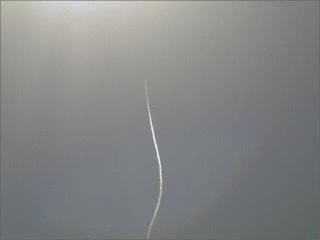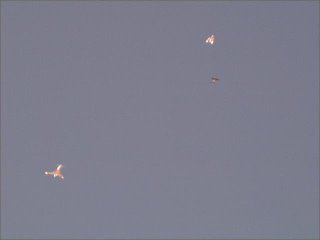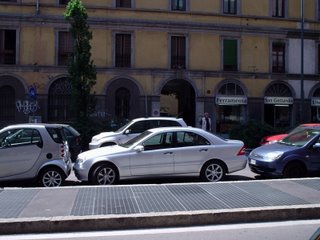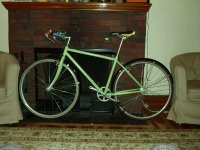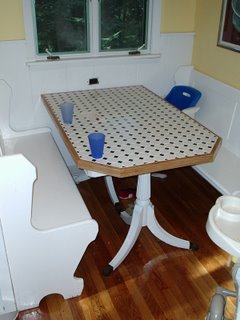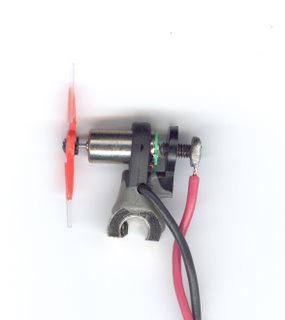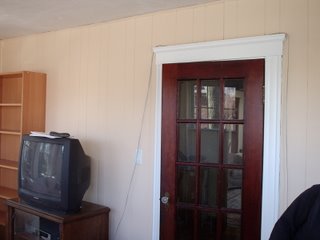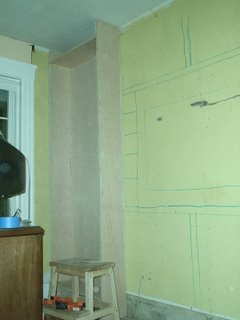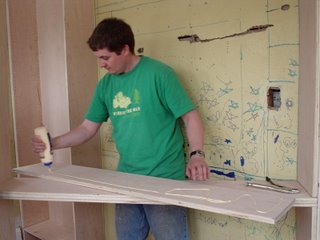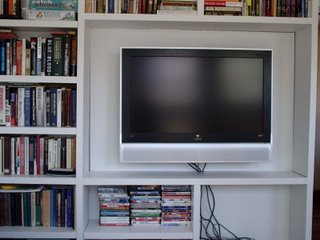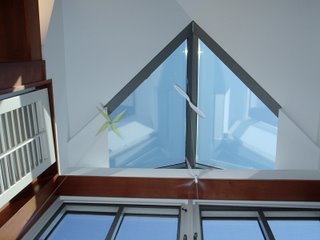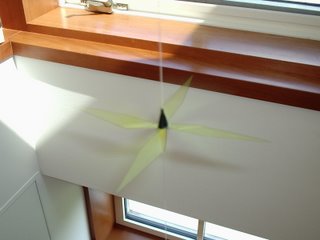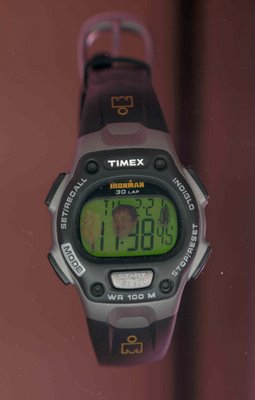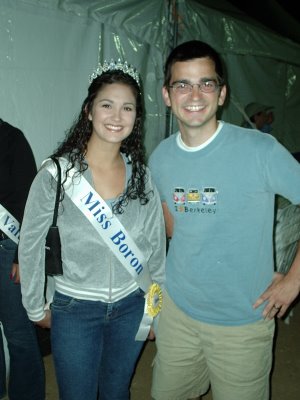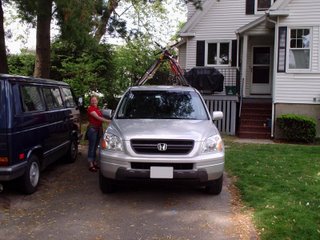(This posting is a modified reprint of a webpage on my old website)
Most days, I commute on my fixed gear Diamond Back hybrid or on my Van Dessel Superfly. The Van Dessel is a great urban bike. It is equipped with a 7-speed Shimano Nexus hub. I have been very happy with the Nexus system. Its shifting cable and apparatus is inside the chainstays, which is really nice because it can't be damaged by walls, curbs, or other bikes. It looks like this:
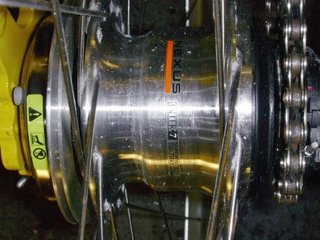 My happiness both with the Shimano and with the fixed gear bike has led to me explore a solution that encompasses the most attractive features of internally geared hubs and of fixed gears. I like having multiple gears at my disposal. I also like the simplicity of a fixed gear bike, with its lack of cables and extra "stuff" on the bike. I also like rear brakes for the winter. I ride in the snow and ice, and I think it is stupid to ride in low-traction conditions without a rear brake. I was talking with one of the guys at the bike shop (who has been commuting on a fixed gear bike since like 1965) about this, and he said that some serious commuters build up winter commuting wheels around kids bike coaster brake hubs. They like coaster brakes because there are no shifter cables to be corroded by the salt water.
My happiness both with the Shimano and with the fixed gear bike has led to me explore a solution that encompasses the most attractive features of internally geared hubs and of fixed gears. I like having multiple gears at my disposal. I also like the simplicity of a fixed gear bike, with its lack of cables and extra "stuff" on the bike. I also like rear brakes for the winter. I ride in the snow and ice, and I think it is stupid to ride in low-traction conditions without a rear brake. I was talking with one of the guys at the bike shop (who has been commuting on a fixed gear bike since like 1965) about this, and he said that some serious commuters build up winter commuting wheels around kids bike coaster brake hubs. They like coaster brakes because there are no shifter cables to be corroded by the salt water.
So I started poking around on eBay and stumbled onto two-speed "kickback" hubs, which came standard on many kids bikes in the 70s. Kickback hubs are equipped with coaster brakes (no cables) and they can toggle between two different gears when the rider applies slight backpedal pressure. I thought I would try to build a commuter around one of these hubs. As far as I can tell, these hubs were built by two companies--Bendix and Sachs. The Bendix units came in different gearing flavors and with different brakes. According to Sheldon Brown, they are heavier than the Sachs units. Also, the cogs on the Sachs units are easily changeable, and they use the same three-peg cogs used on Shimano and Sturmey-Archer hubs. The Bendix cogs are not easily swappable. Most important to my aesthetic sensibility, however, is the the fact that the Sachs unit is Made in Germany. I really like German-made machinery. So I found a 36-hole Sachs Torpedo Duomatic two-speed hub on eBay and bought it. This is what it looked like:
 When it arrived, I debated with myself for a day over whether I should open it up and clean it up before committing to building a bike around it. I even emailed Sheldon Brown to ask his opinion. He graciously responded, advising me not to fix what isn't broke. I decided to act against his advice. I have taken apart automobile engines and put them back together and I was reasonably confident I could at least put this thing back together. Before opening it up, I verified that it worked by turning it by hand. In operation it is really cool. (Parenthetically, after I disassembled it, I found a German website with an exploded parts diagram for the Duomatic. I didn't really need it, but it is nice to have. This is the parts diagram. I hope I am not violating someone's copyright by reproducing it here.)
When it arrived, I debated with myself for a day over whether I should open it up and clean it up before committing to building a bike around it. I even emailed Sheldon Brown to ask his opinion. He graciously responded, advising me not to fix what isn't broke. I decided to act against his advice. I have taken apart automobile engines and put them back together and I was reasonably confident I could at least put this thing back together. Before opening it up, I verified that it worked by turning it by hand. In operation it is really cool. (Parenthetically, after I disassembled it, I found a German website with an exploded parts diagram for the Duomatic. I didn't really need it, but it is nice to have. This is the parts diagram. I hope I am not violating someone's copyright by reproducing it here.)

I am glad I opened it up, not only because I discovered a few problems, but also because the hub is a mechanical wonder. The machining is beautiful. It reminds me of the insides of a Porsche engine or of a Heckler and Koch rifle (don't ask how I know about that). Here is what it looked like as I started to open it up. I opened the cog side first (the side that doesn't have the coaster brake arm on it):

 I slid parts onto a zip tie and took photos so that I would be able to keep track of them. I honestly don't know what most of these parts are called (in English, as least), but I kind of think I know what most of them do. The principle on which this thing operates is that it is always trying to shift gears, but forward pressure on the pedals makes it so that it can't slip into the other gear. If you apply back pressure, it allows a spiral part (called an "Antriebuchse") to turn and engage the "Bremskonus," shifting gears.
I slid parts onto a zip tie and took photos so that I would be able to keep track of them. I honestly don't know what most of these parts are called (in English, as least), but I kind of think I know what most of them do. The principle on which this thing operates is that it is always trying to shift gears, but forward pressure on the pedals makes it so that it can't slip into the other gear. If you apply back pressure, it allows a spiral part (called an "Antriebuchse") to turn and engage the "Bremskonus," shifting gears.


As I cleaned and disassembled, I found that a few of the bearing race surfaces were pitted. There are three roller bearings in the hub. Each roller has a cone and a ring (each of which is a race) and each has a cage with ball bearings in it. Of the three bearings, two had some pitting. The bearing on the lever arm side of the hub was in the worst shape. Both of its races were pitted and the ball bearings themselves were a bit dulled from having traveled over pitted races. My guess is that moisture got into the hub and rusted the race surfaces. On the other side, the outer race surface on the "Planetenradträger" was badly pitted. This part is seen below. It is a really neat piece of machinery. It contains three little planetary gears, held in place by three little shafts. When these planets are removed, the large bearing can come off. It is very much like field stripping an HK rifle.

The Planetenradträger contains two bearings. The smaller roller bearing inside was in good shape. But the outer one was badly pitted. An indication of how bad things were is that the ball bearing from this side were completely dulled by having run over the pits. Here are some blurry photos. I have circled the areas with pits. Notice how dull the ball bearings are:

Now, in all honesty, I probably could have just greased the thing up at this point and put it back together. It's not like I am rebuilding a nuclear reactor or a jet engine here. But I decided to go for broke and refurbish the bearings myself. I own a small metal lathe, and this made the project possible. I chucked the part into the lathe and turned it down to a fairly slow speed. I zip-tied my Dremel tool to the tool post in approximately the right position to grind out the pits in the race with a small abrasive bit (note that the aluminum chips laying around aren't from this project--I was practicing bad machine tool hygiene by not cleaning up after the last project) :

Now, this method of attaching the Dremel may seem a little imprecise. It is. But that type of precision turns out not to be important for this operation. All that is really needed is a constant grind around the race. This is made possible by the rotation of the lathe and the fast rotation of the Dremel. The "float" created by the contact between the abrasive tool and the race keeps the two in a relatively constant relationship. I only took out a few thousandths of an inch, just enough to get below the bottom of the deepest pit in the race. As I understand it, the final shape of the race doesn't matter much as long as it is in certain bounds. Its main job is to have a concave surface against which to trap the ball against the concave surface of the opposing race. Far more important is the surface finish, which needs to be really nice and shiny. To get this, I risked losing a finger by polishing with emery cloth:

At first, the emery paper made a little musical note against the striations left by the grinding process. But as the striations were polished out, the process became quieter. I found that wrapping the emery cloth around the end of a wood ruler created a good tool for pushing into the races. I subsequently ground and polished the two other pitted races in a similar fashion. Here is one of the newly reground and polished races:

The races look really good--nice and shiny. I purchased two packets of new ball bearings at the local bike store and popped them into the old cages. They are 3/16" bearings. I micrometered the old and new ones because I was afraid that the hub would require metric bearings and that Wheelworks had given me English ones. The new and the old bearings were exactly (EXACTLY) .1875 inches, so they are EXACTLY right. Here are the reground races with their shiny new bearings:

One final unresolved question was whether I had ground away too much of the hardened bearing surface and exposed soft steel underneath. This would be bad because the hardened ball bearings would push into soft race material and eventually kill the race surface. I spoke with one of my friends who is possibly the world's preeminent metallurgist, and he felt that I would be fine. I ground off very little, and the material underneath is likely quite hard.

The hub went back together perfectly. I greased the bearings with Phil Wood's grease, and put a few teaspoons of Mobil 1 Synthetic oil in the oil nipple. This was my best guess given what people recommend for lubing other internal hubs.
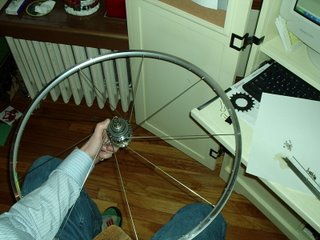
I laced up the hub with a Mavic 700c rim and DT Swiss spokes. There are 36 spokes, and I had to put tiny brass washers on the spoke heads because the Sachs steel is hard and does not "give" against the spokes the way aluminum does.

I mounted the wheel on my Redline Monocog and commuted for part of the 2005-2006 winter on the bike. It is AWESOME. I may end up selling the wheel, because I really am having a good time on the fixed gears.




